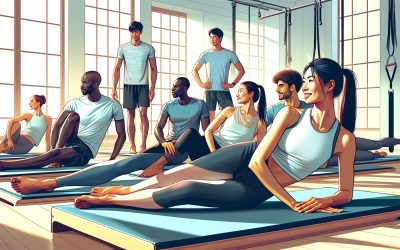Yoga isn’t just about bending and twisting into intricate shapes; it’s a journey towards achieving greater flexibility and a deeper connection between the mind and body. For many, it’s the key to unlocking a sense of harmony and well-being that transcends the physical benefits.
Embarking on this yoga journey can transform one’s approach to daily life, fostering a sense of inner peace and resilience. Whether you’re a beginner curious about the basics or a seasoned practitioner aiming to deepen your practice, yoga offers a path to enhancing both your physical and mental flexibility.
Benefits of Yoga for Flexibility
Yoga is not just about striking the perfect pose; it’s a journey towards achieving complete flexibility and an improved range of motion. People often overlook the fact that flexibility is not a prerequisite for yoga, but a benefit that comes with consistent practice. This section dives into the perks of incorporating yoga into one’s routine for enhanced flexibility.
Increases Range of Motion
Regular yoga practice gently stretches and strengthens muscles, which is key in enhancing one’s range of motion. Not only does this make everyday activities easier and less prone to injury, but it also improves performance in other physical activities. By fostering flexibility in the muscles and joints, yoga ensures a smoother, more fluid range of movement which allows individuals to enjoy a heightened sense of freedom in their bodies.
Reduces Risk of Injury
One of yoga’s standout advantages is its ability to decrease the likelihood of injuries. Flexible muscles are less susceptible to damage since they can handle more physical stress. For athletes and physically active individuals, this means less downtime and quicker recovery. Additionally, yoga’s focus on alignment and proper form teaches practitioners to move their bodies in ways that reduce strain and overuse injuries.
Promotes Muscle Recovery
After intense physical activity, muscles need time to recover, and yoga can significantly expedite this process. Stretching through yoga poses increases blood flow, delivering much-needed oxygen and nutrients to tired muscles. This not only accelerates the recovery process but also alleviates soreness, helping bodies bounce back quicker from workouts.
Enhances Functional Flexibility
Functional flexibility is vital for carrying out daily tasks with ease and efficiency. Through yoga, people gain the flexibility necessary to perform movements that are essential for quality of life, such as bending, reaching, and twisting. This aspect of flexibility is especially important as individuals age, ensuring that they maintain their independence and mobility.
While the journey to increased flexibility through yoga might be gradual, the benefits are both immediate and long-lasting. The mindful approach to stretching not only aids in achieving a greater range of motion but also encourages a deeper connection with one’s body, highlighting the importance of patience and persistence in the pursuit of physical well-being. Yoga practitioners often notice improvements not only in their flexibility but in their overall sense of balance and movement, underscoring yoga’s comprehensive approach to health.
Importance of Mind-Body Connection in Yoga
In the journey of using yoga for flexibility, one cannot overlook the profound impact of the mind-body connection. This intrinsic relationship is the cornerstone of yoga, guiding individuals toward a deeper understanding and harmony within themselves. Through mindful practice, yoga offers a unique pathway to bridging the gap between physical movements and mental tranquility.
Yoga’s essence is rooted in the synchronization of breath and movement. This harmonization enhances concentration, allowing practitioners to delve deeper into each posture with intention and awareness. It’s not merely about achieving a more flexible body; it’s about nurturing a flexible mind that can adapt and respond to life’s ebb and flow with resilience and grace.
The mind-body connection in yoga also manifests through heightened body awareness. As individuals become more attuned to their body’s signals and nuances, they cultivate a mindful presence. This awareness transcends the yoga mat, encouraging a more engaged and conscious approach to daily activities and interactions.
Moreover, yoga’s emphasis on mindful breathing plays a pivotal role in fostering this connection. Breathing techniques, or Pranayama, regulate the nervous system, reducing stress and promoting a state of calm. In moments of deep stretches and challenging poses, it’s the controlled breath that becomes a tool for staying present and centered.
Yoga’s practice instills a sense of inner peace and emotional balance. By focusing on the present moment, individuals often experience a reduction in anxiety and an increase in mental clarity. This emotional stability is a direct outcome of the mind-body connection, empowering individuals to face life’s challenges with a grounded and composed mindset.
Furthermore, the discipline required in maintaining a regular yoga practice strengthens mental fortitude. Each session is an opportunity to practice patience, perseverance, and self-compassion, reinforcing the mental resilience that is crucial for personal growth and well-being.
In essence, the importance of mind-body connection in yoga extends far beyond physical flexibility. It’s about creating a harmonious dialogue between the mind and body, a dialogue that nurtures not only physical health but also mental and emotional well-being. Through consistent practice, yoga becomes a transformative journey, sculpting not only the body but also the mind, into its most flexible, resilient form.
Basic Yoga Poses for Flexibility
Yoga is a journey that begins with a single pose, or asana, and it’s this journey that brings with it the promise of improved flexibility, strength, and a deepened mind-body connection. For those new to yoga or looking to enhance their flexibility, certain poses stand out for their effectiveness. These poses are not only foundational to developing a more limber body but also in fostering a more profound mental resilience and awareness.
Downward-Facing Dog (Adho Mukha Svanasana)
This widely recognized pose stretches the shoulders, hamstrings, calves, and hands while strengthening the arms and legs. By inverting the head below the heart, it also offers a dose of rejuvenation to the brain, making it both a physical and mental exercise. Beginners might find their heels don’t quite touch the ground at first, but with regular practice, notable improvements often emerge.
Forward Fold (Uttanasana)
The Forward Fold is a simple yet powerful pose that works wonders for the hamstrings and lower back. It’s a grounding posture that also helps to calm the mind, making it especially beneficial for releasing stress. Practitioners are encouraged to keep a slight bend in the knees to prevent strain.
Cobra Pose (Bhujangasana)
Ideal for those seeking to improve spine flexibility and strengthen the back muscles, the Cobra Pose opens up the chest and shoulders. It’s a gentle backbend that promotes better posture and can alleviate discomfort resulting from long periods of sitting.
Warrior II (Virabhadrasana II)
This pose is a dynamic stance that targets the legs, groin, and chest, promoting increased stamina and concentration. While holding the Warrior II pose, the focus on deep, steady breathing enhances endurance and mental clarity.
Pigeon Pose (Eka Pada Rajakapotasana)
Known for its deep hip-opening qualities, the Pigeon Pose is essential for those looking to enhance lower body flexibility. It also allows for an emotional release, as the hips are a common area where stress and tension accumulate.
Incorporating these poses into a regular yoga practice can significantly improve flexibility and foster a stronger connection between mind and body. The key is consistency and patience; flexibility won’t happen overnight, but with dedication, the transformation can be profound. Whether you’re a seasoned yogi or a beginner, these poses offer a starting point towards achieving a more flexible and resilient self.
Advanced Yoga Techniques for Mind-Body Connection
After mastering the basics, yogis often seek advanced techniques to deepen their practice and enhance the mind-body connection. Beyond simple poses, these advanced methods focus on the integration of breath, movement, and meditation to attain a higher state of awareness and flexibility.
One such technique is Pranayama, or controlled breathing. This practice involves varying breathing patterns to control the life force or Prana within the body. Techniques like Kapalabhati (Skull Shining Breath) and Anulom Vilom (Alternate Nostril Breathing) not only improve lung capacity and oxygenation but also prepare the mind for meditation by calming the nervous system.
Another advanced practice is Bandhas, often referred to as body locks. These involve contracting certain muscles to control the flow of energy within the body. The three main Bandhas – Mula Bandha (Root Lock), Uddiyana Bandha (Abdominal Lock), and Jalandhara Bandha (Throat Lock) – when engaged together, are known as the Maha Bandha or the Great Lock. Practicing Bandhas increases physical strength, enhances breathing capacity, and contributes to a deeper meditative state.
Furthermore, incorporating Meditation and Mindfulness into a yoga practice can significantly deepen the mind-body connection. Techniques such as Vipassana (Insight Meditation) and Zazen (Seated Meditation) encourage yogis to observe their thoughts without attachment, promoting mental clarity and emotional stability. This mindful approach to yoga helps practitioners stay present, enhancing the physical benefits of yoga with a profound sense of mental peace.
For those looking to challenge their physical limits, Ashtanga Yoga offers a rigorous sequence of poses that help build flexibility, strength, and stamina. Unlike other forms, Ashtanga follows a fixed order of poses, promoting discipline and dedication. The intensity of the practice not only refines physical abilities but also fosters a meditative focus as one moves seamlessly from one pose to the next.
Ultimately, advancing in yoga is about more than just physical flexibility or strength; it’s about nurturing a deeper connection between mind and body. Through practices like Pranayama, Bandhas, and focused meditation, individuals can explore the vast potential of their inner selves, unlocking levels of awareness and resilience that resonate both on and off the mat.
Tips for Enhancing Your Yoga Practice
When it comes to deepening your yoga practice, consistency is key. However, simply rolling out your mat every day might not be enough to achieve the profound mind-body connection and flexibility you’re seeking. There are several strategies you can integrate into your routine to elevate your yoga journey.
Start with a Clear Intention
Setting an intention for each practice can significantly influence your focus and outcome. Whether it’s cultivating gratitude, releasing stress, or improving flexibility, a clear intention serves as a guide, keeping you anchored throughout your session. This mental clarity not only deepens your practice but also enhances the connection between your mind and body, allowing for a more fulfilling yoga experience.
Incorporate Props
Yoga props such as blocks, straps, and bolsters aren’t just for beginners; they’re powerful tools for advanced practitioners aiming to explore deeper stretches and poses safely. Props can help:
- Improve alignment
- Enhance flexibility
- Provide support in challenging poses
Utilizing props can make seemingly impossible poses accessible and can introduce a new dimension to your practice.
Listen to Your Body
Listening to your body is paramount in yoga. It’s easy to get caught up in achieving the ‘perfect’ pose, but yoga is about the journey, not the destination. Paying close attention to your body’s signals prevents injuries and fosters a more intuitive practice. If a pose feels uncomfortable, modifying it to suit your body’s needs on any given day can make your practice more productive and enjoyable.
Embrace Patience and Consistency
Improvements in flexibility and the mind-body connection won’t happen overnight. Yoga is a lifelong practice that requires patience and persistence. Celebrate the small victories, like noticing a slight increase in flexibility or feeling more centered during meditation. Consistency is essential, even if it means practicing for just a few minutes on busier days.
Engage in Regular Meditation
Incorporating meditation and mindfulness into your yoga practice can exponentially increase its benefits. Meditation helps in cultivating a state of mental clarity and calmness, which directly influences your physical practice by allowing deeper focus on poses and breath work. Beginning or ending your yoga session with a few minutes of meditation can profoundly affect your overall well-being.
Conclusion
Embracing these advanced yoga techniques and tips can truly transform one’s practice from merely physical exercises to a profound journey of self-discovery and connection. Whether it’s through the focused breath of Pranayama, the discipline of Ashtanga, or the mindful use of props, each element plays a crucial role in deepening the mind-body connection. Remember, the path to flexibility and inner peace is a personal one. It’s not about perfection but progress and the willingness to listen to and learn from one’s own body. With patience, consistency, and a clear intention, the benefits of yoga can unfold in unexpected and beautiful ways, enhancing both physical flexibility and mental clarity. So roll out your mat, set your intention, and let your yoga journey be a gateway to discovering the limitless potential within.
Elizabeth Redd: I am a passionate advocate for Health and Healing, dedicated to empowering individuals to live their best lives.
As the founder and publisher of Health and Healing, I have established myself as a guiding force in the wellness industry.
I am committed to providing the latest research, holistic approaches, and inspiring stories to open new possibilities for your health and healing journey.
Learn more about Elizabeth and Join Us at Health and Healing. Also, check out My About Page.





0 Comments